To properly dry foods in a solar dehydrator, you'll need to maintain temperatures between 100-140°F and guarantee good airflow through screened vents. Position your dehydrator facing the sun and adjust the angle based on your location. Most fruits take several days to dry completely, while vegetables typically need 2-3 sunny days. You'll want to slice items uniformly and less than half an inch thick, arranging them in single layers on clean trays. Monitor humidity levels (keep below 60%) and protect food from nighttime moisture by covering or moving indoors. Understanding the specific requirements for different foods will help you achieve ideal preservation results.
Essential Solar Dehydrator Setup
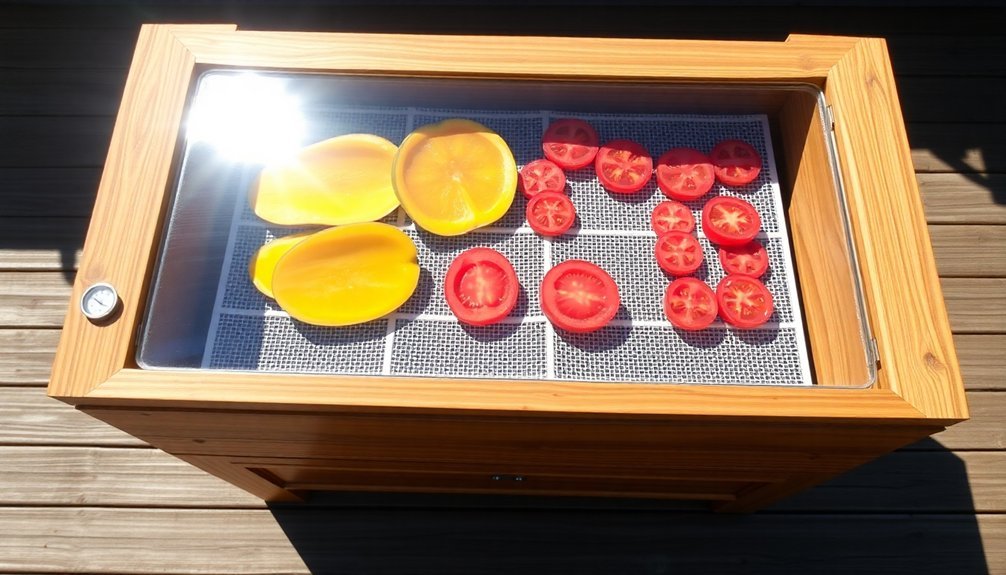
For ideal performance, you'll need to face your dehydrator toward the sun, adjusting the angle based on your location and season.
Interior reflectors and foil can boost drying capacity by raising temperatures over 20 degrees inside the unit.
Consider adding wheels for mobility and position braces to support all components securely.
Don't forget to install metal louvers with insect screening for ventilation, and make certain the top cover is airtight to prevent moisture from entering.
A long-probe thermometer will help you monitor internal temperatures effectively.
Temperature Control and Monitoring
You'll need to check your solar dehydrator's temperature range at least twice daily to guarantee different foods maintain their required heat levels, from herbs at 95°F to meats at 155°F.
To adjust the heat effectively, you can use auxiliary heaters, integrated light bulbs, or adjustable vents when solar radiation isn't sufficient.
Make it a habit to use a long-probe thermometer for accurate readings, and don't hesitate to reposition your dehydrator or modify its covering to achieve the perfect drying temperature. A pyranometer and thermocouples can provide precise data monitoring to ensure optimal drying conditions throughout the process.
Daily Temperature Range Checks
Maintaining precise temperature control is essential for successful solar food dehydration. You'll need to check your dehydrator's temperature at least twice daily to verify your food stays within its ideal drying range. For herbs, you're aiming for 95°F, while fruits need around 135°F, and meats require higher temperatures of approximately 155°F.
Install a kitchen thermometer with a long probe that can measure between 90-200°F for accurate monitoring. You can use Arduino-based systems with thermocouples for automated temperature tracking, which will store your readings on flash memory or SD cards for later analysis. The historical roots of food preservation show that wooden drying racks were used by ancient Egyptians to achieve consistent results.
If you've installed an LCD display, you'll be able to view real-time temperature data and program alerts for when temperatures fall outside your desired range.
To adjust temperatures throughout the day, you'll need to orient your dehydrator towards or away from direct sunlight. If you're using a combination dryer, activate your auxiliary heaters when solar radiation isn't sufficient.
For uniform drying, verify your fans are working properly to maintain homogeneous temperatures throughout the unit. Regular cleaning of your monitoring equipment will help maintain accurate readings.
Heat Adjustment Best Practices
Through careful temperature control, successful food dehydration depends on maintaining precise heat levels within specific ranges. You'll need to keep temperatures between 100°F and 140°F for most foods, while specific items require different ranges: yogurt (110°F-120°F), vegetables (115°F-130°F), fruits (125°F-135°F), and meat (155°F).
To maintain ideal temperatures, you'll want to place thermometers near your drying screens and check them regularly. Keep the rear door open when needed, and adjust your solar dehydrator's angle to capture maximum sunlight.
Don't let foods receive direct sunlight, as this can cause vitamin loss and uneven drying. You can regulate heat using auxiliary heaters or light bulbs when solar energy isn't sufficient.
Install black metal screens or absorber surfaces to maximize heat absorption, and use desiccant beds to help control moisture levels. Remember to balance temperature with proper airflow by adjusting vents and ensuring adequate air circulation.
If temperatures rise above 180°F, your food will cook instead of dehydrate, while temperatures below 100°F risk bacterial growth. Monitor these conditions closely to achieve the best results.
Food Preparation Guidelines
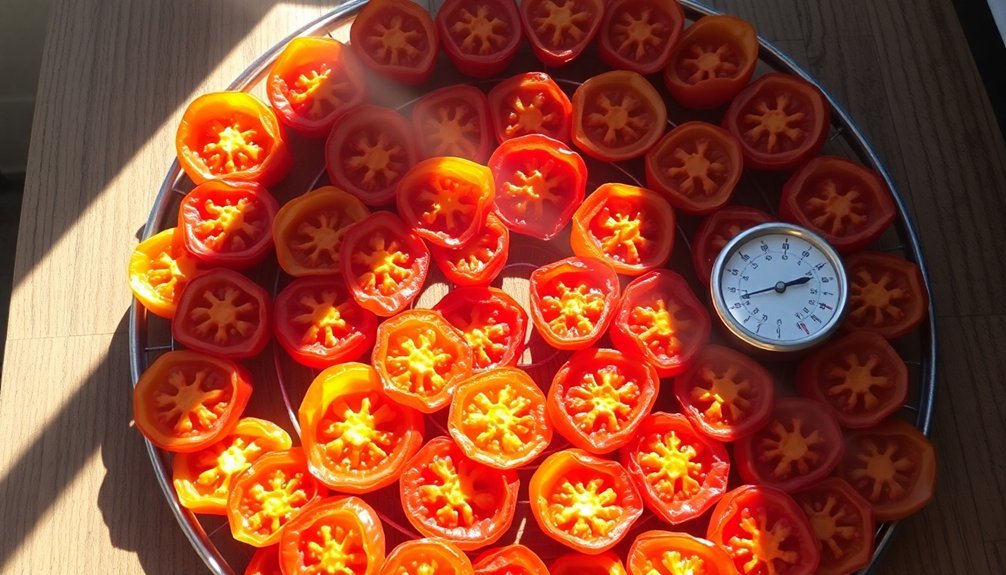
Successful food dehydration starts with proper preparation techniques and hygiene practices. Before you begin, wash your hands thoroughly and guarantee all your utensils, trays, and work surfaces are clean and sanitized.
Select foods that are suitable for drying, avoiding items high in fat or oil as they won't dehydrate properly.
When preparing your foods, wash them carefully with clean water and remove any damaged or spoiled portions. Cut your items into uniform pieces to guarantee even drying throughout the process.
Arrange the food pieces in single layers on sanitized trays, leaving enough space between items for proper air circulation. If you're drying different types of foods, keep them separated in different compartments.
- Always use food-safe screen materials to line your drying trays
- Keep prepared foods covered to protect them from insects and contaminants
- Cut pieces to consistent sizes for uniform drying results
- Sanitize all equipment and surfaces before each use
Once your foods are properly prepared and arranged, you'll want to store them in airtight containers in a cool, dark place.
Remember to label and date each container for proper stock rotation and easy identification.
Optimal Drying Conditions
To achieve successful solar dehydration, you'll need to maintain temperatures between 100-140°F, with an ideal target range of 120-135°F for most foods.
Your local climate plays an essential role, as you'll need warm days of at least 85°F and low humidity for effective drying results.
Proper ventilation throughout the dehydration process helps prevent bacterial growth at lower temperatures and avoids cooking your food at higher temperatures.
Temperature Control Basics
Maintaining proper temperature control stands at the heart of effective solar food dehydration. You'll need to keep temperatures between 100°F and 140°F for ideal results, though specific foods may require different ranges.
Most fruits and vegetables dry best between 120°F and 160°F, while herbs can be dried at lower temperatures.
To guarantee proper temperature control, you'll want to monitor your solar dehydrator regularly using a thermometer placed near the drying screen rack. If temperatures climb too high, simply open the rear door to regulate airflow.
You can also adjust your dehydrator's position relative to the sun to maintain perfect temperatures throughout the day.
- Different foods require specific temperature ranges – research your items before starting
- Monitor internal temperature frequently using a properly placed thermometer
- Use temperature control features like auxiliary heaters or desiccant beds when needed
- Keep the rear door adjustable for quick temperature regulation
Remember that temperatures below the ideal range can promote bacterial growth, while excessive heat may cook rather than dehydrate your food.
Some advanced solar dryers come equipped with built-in sensors and automatic timers to help maintain ideal drying conditions throughout the process.
Ideal Climate Factors
Numerous climate factors play significant roles in achieving ideal solar food dehydration. You'll need to take into account solar radiation, ambient temperature, humidity, and air movement to guarantee optimal results.
Strong, consistent solar radiation is essential for efficient dehydration. You'll want to position your solar collector at the best angle for your location, which you can determine using a solar angle calculator. The best drying conditions typically occur during spring and fall when solar radiation is more stable.
Your dehydrator will perform best when ambient temperatures stay between 15°C to 30°C. You'll need to protect your food from nighttime temperature drops to prevent moisture reabsorption. In extremely hot conditions, you might need partial shading to avoid overheating.
Low humidity levels and proper air circulation are critical for successful dehydration. You'll want to avoid operating your dehydrator during rainy or highly humid weather.
Make sure your setup includes effective moisture removal systems and adequate ventilation. Natural convection can help enhance air movement, but you'll need protection from strong winds to maintain stable drying conditions. Think about incorporating wind barriers while still allowing sufficient airflow through your dehydrator.
Storage Best Practices
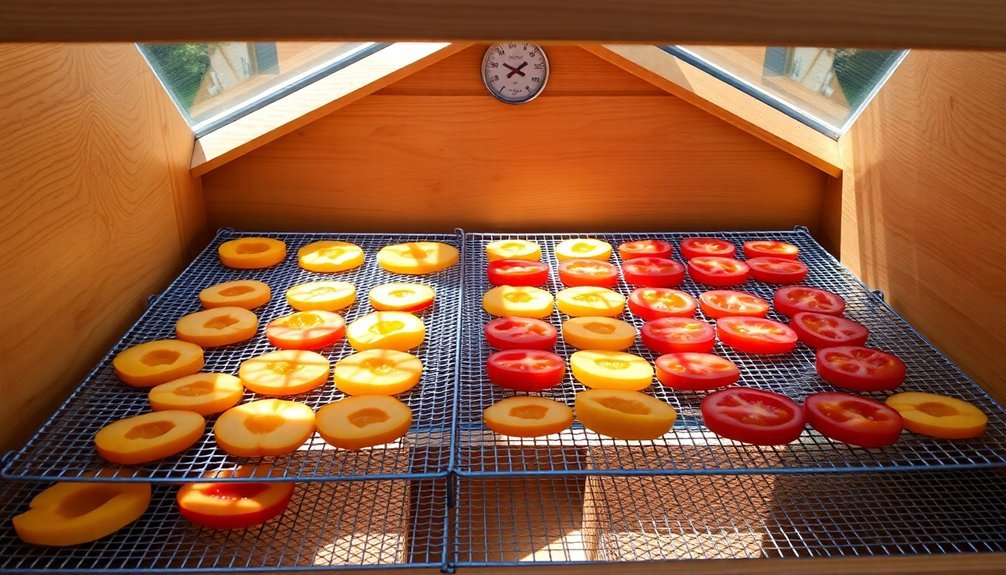
Successful storage of solar-dehydrated foods depends on three critical factors: proper containers, ideal conditions, and thorough preparation.
Choose airtight containers like glass mason jars or retro-style clamp jars with silicone rings to prevent moisture and maintain food quality. For long-term storage, avoid zip-top plastic bags as they won't provide adequate protection against air and moisture.
Before storing your dehydrated foods, let them cool completely and verify they're properly dried. If you're storing fruits, place paper layers between them to prevent sticking.
Store your containers in a cool, dark place with consistent temperature and low humidity to maximize shelf life. When stored correctly, dried vegetables can last up to 10 years, while fruits can maintain quality for up to five years.
- Use glass jars or vacuum-sealed containers for best long-term preservation
- Store in dark, cool spaces away from direct light and moisture
- Check that foods are completely dry and pliable before storage
- Consider using Mylar bags for bulk storage, as they're excellent for maintaining food quality
Remember to keep your storage area free from pests and inspect your containers regularly for any signs of moisture or degradation.
Common Food Drying Times
After mastering proper storage techniques, you'll need to understand typical drying times to achieve the finest results. Different foods require varying periods to dry properly, with fruits typically taking several days depending on their thickness and sugar content.
You'll find that vegetables often need 2-3 sunny days in a solar dehydrator for complete drying. For ideal results, slice your foods less than one-half inch thick and make certain temperatures reach at least 86°F (30°C). Your solar dehydrator can achieve temperatures above 160°F on sunny days, greatly speeding up the process.
Remember to rotate your trays 180 degrees daily for uniform drying. Don't attempt to sun-dry meats, as they require controlled environments due to their high protein content. Instead, focus on fruits, vegetables, and herbs.
Leafy greens and herbs can be air-dried in shade, while fruits like figs and mangos need several days of direct sun exposure. You'll need to protect your food from moisture at night by covering it or bringing it indoors.
Weather conditions will impact your drying times, so plan accordingly and make certain humidity stays below 60% for effective dehydration.
Frequently Asked Questions
Can I Use a Solar Dehydrator During Winter Months?
Yes, you can use a solar dehydrator in winter. Place it in a sunroom, add wheels for sun tracking, and keep snow off the panels. You'll need longer drying times and should bring it inside overnight.
What Happens if It Rains During the Dehydration Process?
If it rains while you're dehydrating food, you'll need to quickly move your dehydrator indoors. Rain can rewet your food, interrupt the drying process, and potentially cause spoilage if you don't act fast.
How Do I Prevent Food From Sticking to Drying Screens?
Use non-stick screens made of stainless steel or plastic mesh. You'll want to slice food thinly, blot excess moisture, and apply acidic marinades like lemon juice. Don't forget to rotate screens periodically.
Is It Safe to Dry Meat in a Solar Dehydrator?
You can safely dry meat in a solar dehydrator if you maintain temperatures between 160-165°F, properly sanitize equipment, trim excess fat, and monitor the process carefully. It's essential to follow food safety guidelines.
Should I Rotate Food Positions Between Upper and Lower Drying Racks?
Yes, you should rotate food between upper and lower racks every 2-3 hours. It'll guarantee even drying, as lower racks typically dry faster. This practice helps prevent over-drying and maintains consistent results.
In Summary
You'll find solar food dehydration rewarding once you've mastered the basics. With proper temperature monitoring, careful food prep, and the right weather conditions, you can create shelf-stable foods that retain their nutrients and flavor. Remember to store your dried goods in airtight containers and check them periodically. When done correctly, solar dehydration offers an eco-friendly, cost-effective way to preserve your harvest.
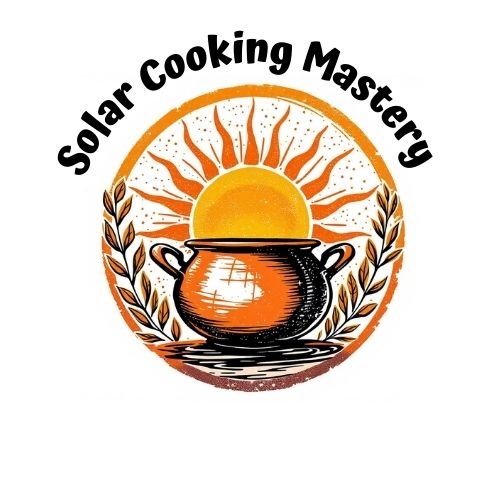
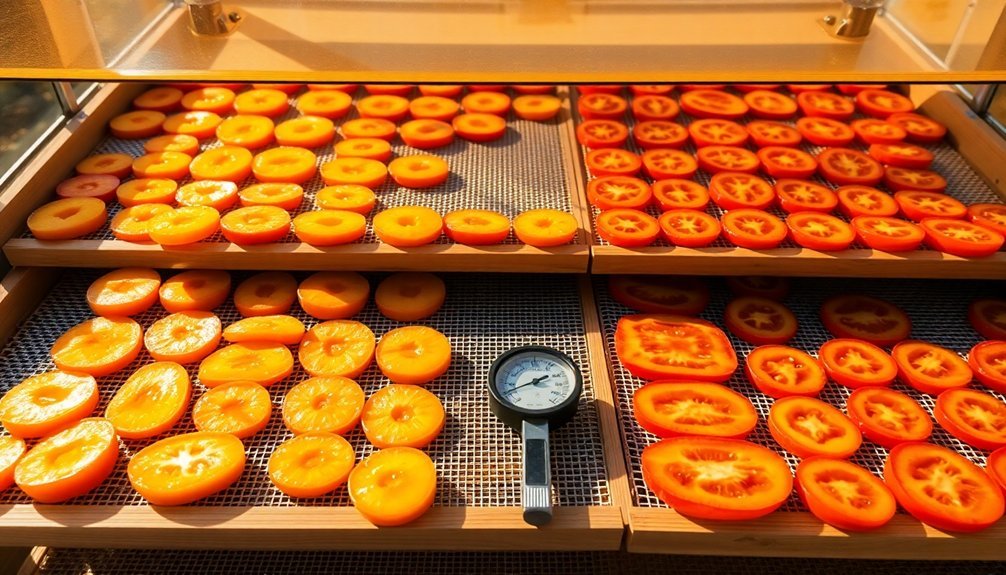
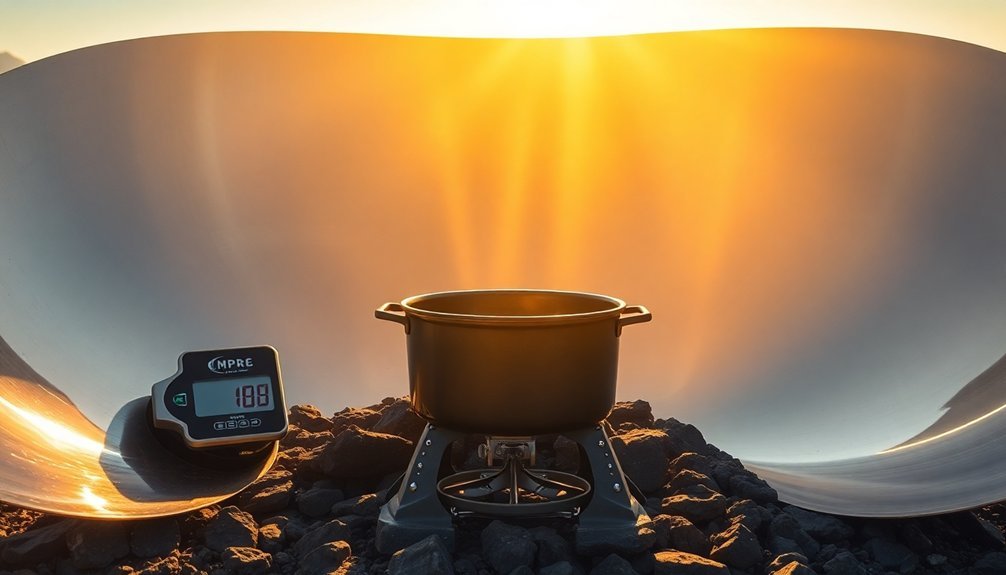
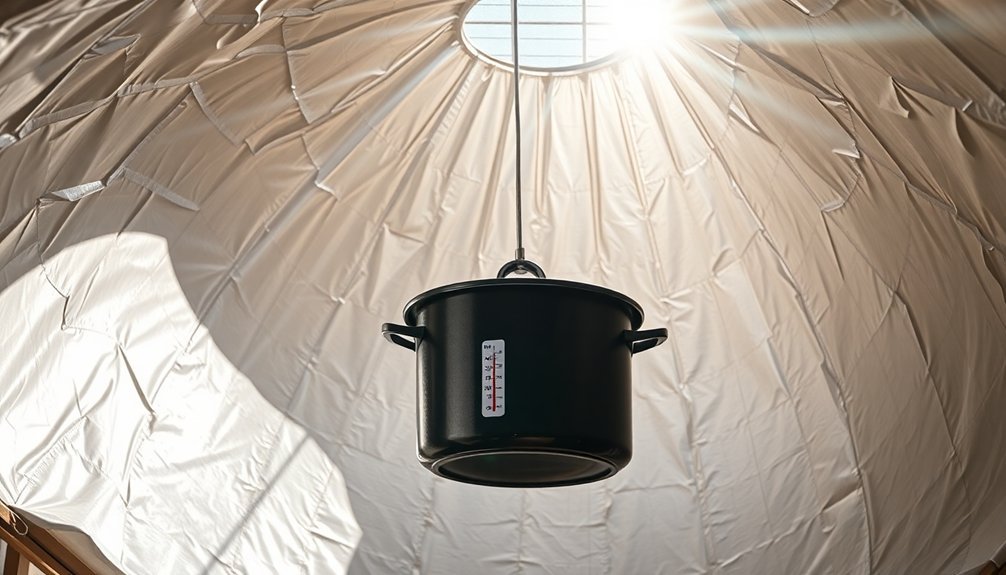
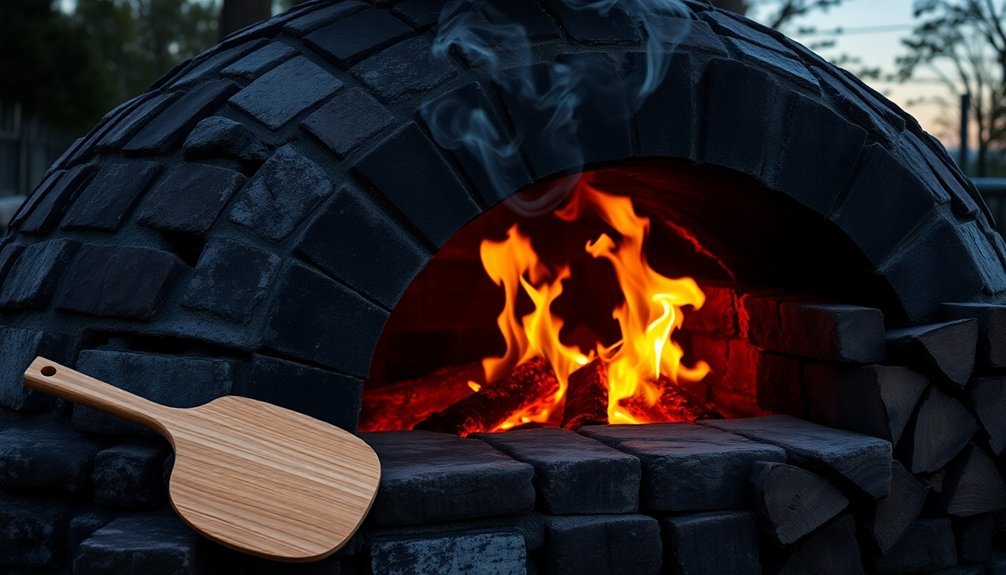
Leave a Reply